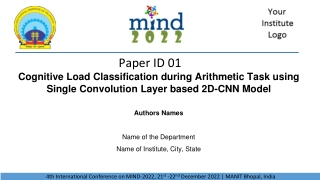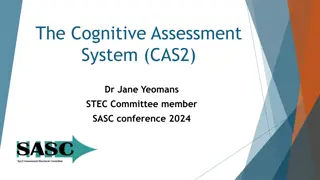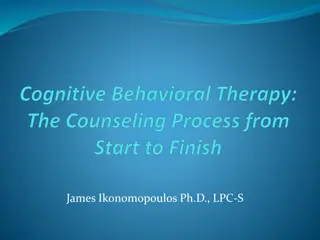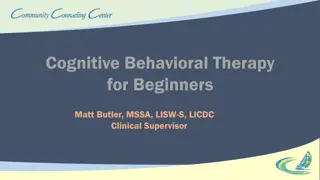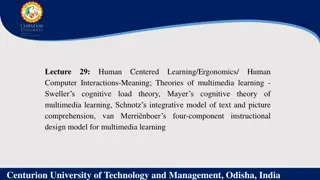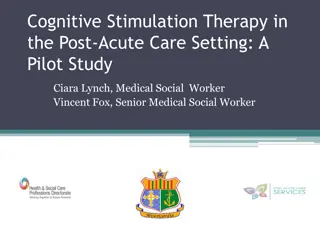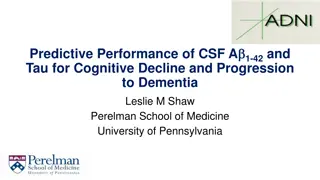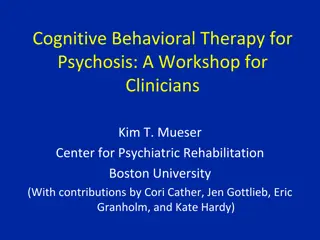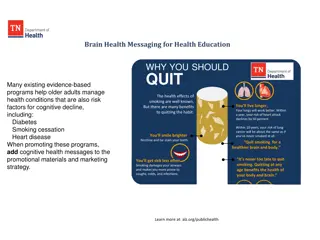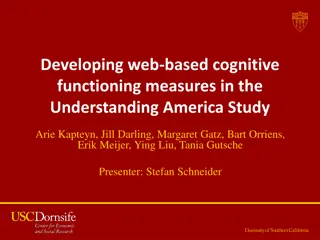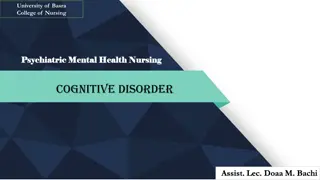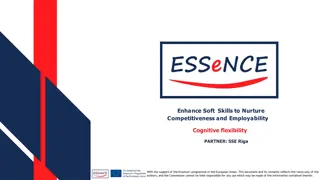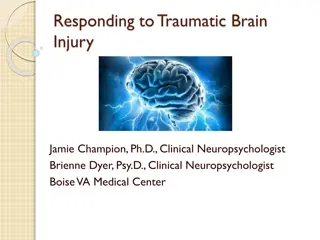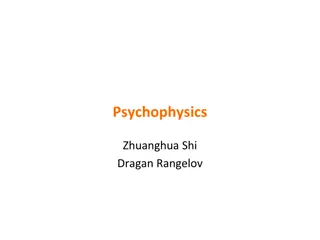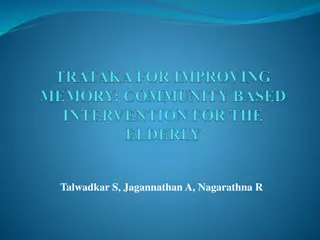FROM VISION TO IDEA: THE COGNITIVE PROCESS OF VISION-DRIVEN IDEA DEVELOPMENT
"Exploring the cognitive process of vision-driven idea development, this study delves into imagination and creativity in generating innovative solutions. By discussing visioning and backcasting as strategic tools, it highlights the importance of creative cognition in idea management and future market insights."
Download Presentation

Please find below an Image/Link to download the presentation.
The content on the website is provided AS IS for your information and personal use only. It may not be sold, licensed, or shared on other websites without obtaining consent from the author.If you encounter any issues during the download, it is possible that the publisher has removed the file from their server.
You are allowed to download the files provided on this website for personal or commercial use, subject to the condition that they are used lawfully. All files are the property of their respective owners.
The content on the website is provided AS IS for your information and personal use only. It may not be sold, licensed, or shared on other websites without obtaining consent from the author.
E N D
Presentation Transcript
25thIPDMC: Innovation and Product Development Management Conference FROM VISION TO IDEA: THE COGNITIVE PROCESS OF VISION-DRIVEN IDEA DEVELOPMENT June 2018 Makoto Isono Tottori University of Environmental Studies Tottori, JAPAN
FROM VISION TO IDEA: THE COGNITIVE PROCESS OF VISION-DRIVEN IDEA DEVELOPMENT 1.. Introduction 2.. Literature Review: Imagining the Future 3.. Research Design 4.. Results & Discussion 5.. Findings & Implications
1. Introduction The approaches to idea generation that attract attention today include visioning (O Connor & Veryzer 2001) or backcasting (Nishimura 2010): imagining a vision or a future context and identifying or generating the strategic insights, technical benefits, or product ideas that can bring the vision to life. -> These approaches are considered worthy of exploration because their application may link advanced technologies to future market opportunities (O Connor & Veryzer 2001) or allow the firm to focus on a specific market target (Reid & Brentani 2014)
1. Introduction This application of imagination described as creative cognition (Finke et al. 1992), examining how these approaches bring about ideas and how they can be managed. study views visioning or backcasting as an
2. Literature Review: Imagining The Future 2-1. Imagination-based idea generation O Connor & Veryzer (2001): Visioning: imagination underlying successful tech-based innovations that comes from how a problem is approached technically. It is an ability to identify compelling benefits of that technology and characterize those in terms of a future market. Visioning is driven by: ruminator, champion, & implementer. Ruminator spends time thinking about the future and is able to connect disparate pieces of information, looking far beyond their present businesses.
2. Literature Review: Imagining The Future 2-1. Imagination-based idea generation Reid & Brentani (2014): Visioning competence consists of divergent-thinking (human networking; market learning) & convergent thinking (idea promotion; market orientation), and the competence is driven by individual divergent-thinking behavior, idea generation behavior. Reid et al. (2014): Project performance created attractiveness of ideas to customers. by visioning includes Idea attractiveness (Reid et al. 2014) Visioning (O Connor & Veryzer 2001) Visioning competence (Reid & Brentani 2014) <- Divergent thinking (human networking; market learning) <- Convergent thinking (idea promotion; market orientation) Individual divergent-thinking & Idea-generation
2. Literature Review: Imagining The Future 2-1. Imagination-based idea generation So-called backcasting, which O Connor & Veryzer (2001) depended on to depict the visioning concept, is a thought approach used for not only tech-enabled innovation but also general innovation. Davis (1987): Backcasting is needed to grasp the reality of a firm s present context and their future context in x years and to think about what change is needed to transform the present to the future context. Visioning orienting toward the future context beyond the present and imagining them. and backcasting have the commonality of
2. Literature Review: Imagining The Future 2-1. Imagination-based idea generation Backcasting (David 1987, etc.) Innovation Idea attractiveness (Reid et al. 2014) Visioning (O Connor & Veryzer 2001) Visioning competence (Reid & Brentani 2014) <- Divergent thinking (human networking; market learning) <- Convergent thinking (idea promotion; market orientation) Individual divergent-thinking & Idea-generation
2. Literature Review: Imagining The Future 2-2. The principle of imagination in creative cognition Finke et al. (1992); Ward & Rebecca (2002): Imagination involves the generation of ideas that go beyond what is presently known, and are directed at some goal. Imagination is influenced by one s existing knowledge framework; a new idea is the product of the restructuring of existing knowledge of characteristic attributes of category exemplars (e.g., a pigeon, a penguin, etc. belonging to the bird category). An idea for a new category exemplar may be generated by retrieval of existing knowledge on two or more different known category exemplars and mental synthesis of their characteristic attributes (Finke et al. 1992).
2. Literature Review: Imagining The Future 2-2. The principle of imagination in creative cognition Category exemplar e.g., Mars Knowledge on the characteristic attribute e.g., Weak gravity, planet like the earth, etc. Idea (new category exemplar) e.g., Martian (Creature with a large head and octopus-like body) Mental synthesis Category exemplar e.g., Creature Knowledge on the characteristic attribute e.g., Head, body, limbs, symmetry, etc. Knowledge on the characteristic attribute of a category exemplar -> category knowledge, or CK Wells, H. G., (1898) The War of the Worlds, Harper & Brothers.
2. Literature Review: Imagining The Future 2-2. The principle of imagination in creative cognition Finke et al. (1992); Ward & Rebecca (2002): People tend to have a common knowledge structure for a category. They tend to use knowledge that is easier to retrieve, making the generated knowledge easier for others to retrieve, too. That means that one s initial trial of imagination toward a certain goal can be something similar to what others imagine, ending up with less creative resolution. Therefore, Finke et al. (1992) suggested that one should make sure that the knowledge used for imagination is truly effective for idea generation.
3. Research Design 3-1. Research Question / What cognitive process works in visioning that contributes to innovative idea generation in a NPD project? / How is it different from the cognitive process in an NPD project where a visioning is not used? / How is a vision imagined and set? / How are ideas generated based on the set vision? The vision-driven idea-generation approach is defined as an approach where a vision is imagined and set, and then ideas are generated against a problem based on the vision.
3. Research Design 3-2. Research methodology Case studies dealing with projects where visioning was utilized were conducted. 3-3. Selection of research subjects 12 projects where visioning was used + 3 projects where visioning was not used. 11 managers (3 MDs, 2 EDs, 6 DDs) were interviewed (3 involved in both, 1 involved 2 visioning projects). Industries included household care products, food products, beauty care, AV equipment, industrial machinery, local products, banking, and food & beverage services. The interviews were conducted from August 2015 to Dec 2017. apparel, interior goods,
3. Research Design 3-4. Interview protocol The semi-structured in-depth interview method. Questions asked: project outlines, development processes, reasons for the use of visioning, project performance judgment 3-5. Project performance evaluation Most projects reviewed were at the stage before or just after their market introduction, therefore a manager s judgment with respect to their project performance was noted. The innovation typologies listed by Garcia & Calantone (2002) were used to assess the type of innovation as marked by project performance, developed: market newness, newness to the firm. i.e., whether newness, project technology or
4. Results & Discussion 4-1. The cognitive process of visioning The cognitive process of visioning was such that (1) a vision (or a future context) on the project problem was imagined and set, and then (2) products as things to bring that vision to life were imagined. The observed generation mode of visions and product ideas as vision constituents can be summarized as the mental synthesis of knowledge on the characteristic attributes of two or more category exemplars (i.e., category knowledge, or CK).
4. Results & Discussion 4-1. The cognitive process of visioning The vision is drawn from mental synthesis between: CK of insights from research on market/tech. development or CK on manager s beliefs CK of present customers or contexts x Product ideas are drawn from mental synthesis between: CK of the vision x CK of the project problem Reid & Brentani (2014): the visioning is a competence related to organization s divergent and convergent thinking. The findings support them from the view of a managers cognitive processes.
4. Results & Discussion 4-1. The cognitive process of visioning CK of insights from research on market and tech. development or manager s beliefs e.g., IoT and AI technology CK: category knowledge, or knowledge on the characteristic attribute of a category exemplar CK of the set vision e.g., G1: active seniors express their originality using IoT and AI technologies Mental synthesis Mental synthesis CK of the present context e.g., the elderly CK of a new product (a product idea) e.g., G1: AI-installed kitchen system as a cooking partner CK of the project problem e.g., system kitchen (1) The innovativeness of product ideas may depend on what CK of the set vision was chosen in imagining products. (2) The innovativeness of the vision may depend on what CK of insights from research or the manager s beliefs were chosen in imagining visions.
4. Results & Discussion Inter- viewee Belonging Project area Process Mental synthesis for vision imagination Vision Mental synthesis for product imagination Morning dew +detergent Product Idea Innov- ation A CD 15yr Large firm A1: House- hold care Visioning (i)(sc) Natural Freshness +Daily life Everyday life with freshness felt like morning after the rain New functional detergent MN/- /FN A2:House- hold care B: AV equipment C: Food New deodorizer MN/- /FN -/- /FN MN/- /FN MN/- /FN -/- /FN -/- /FN B CD 25yr MD 22yr CD 23yr Large firm Visioning (i)(sc) Visioning (i)(st) Visioning (i)(sc) Earth value +Daily life Family meal when one was small +Solo meal Treat +Senior in the mall Senior relaxed in the Life with the earth s beat felt Meal with family members together Nature sound +AV business Family meal+ Seasoning Relaxed senior +cafe Coffee stall in the mall Forest sound live delivery service Seasoning for family sushi party C Large firm D Large firm D1: Food mall D2: Food New functional tea drink Premium hair care brand line-up E CD 15yr Freelance E: Beauty care Visioning (b)(st) Aristocratic beauty +Ordinary woman Life like French princess in the 16th cent. French princess +Hair care F CD 25yr Freelance F1: Banking Visioning Cafe +Daily life Daily life with my favorite cafes Kids running around after school Active senior mastering AI Cafe +Banking Playing + School backpack Smart senior +system kitchen New local banking service New functional backpack for kids AI embedded UD system kitchen New industrial machine model Globally popular local product Mental and physical health forecast device MN/- /FN -/- /FN MN/TN /FN -/- /FN -/- /FN MN/TN /FN (ib)(st) F2: Apparel Visioning Kids playing in a park +Kids going to school AI +Senior today (b)(st) G CD 25yr Freelance G1: Interior Visioning (i)(st) G2: Industrial H: Local products I: IT H MD 30yr ED 15yr University Visioning (ib)(sc) Visioning (i)(st) Popular town +Town passed by Atami as the aged town model +Japan today Old farming in hometown +Consumption today Quality and healthy life+Life of today No. 1 favorite town to live Japan in 30yrs as healthy aged society Global product +Local product Healthy senior +Sensing tech. I Consulting J MD 20yr Mid-sized firm Visioning (b)(sc) Dietary & farming education in hometown Organic bakery +Cooking class +Hometown Relaxing time +drink pkg Locavore shopping mall in hometown MN/- /FN J F&B service K ED 25yr Large firm K:Food Visioning (i)(sc) A bit of luxury New pkg structure -/TN /FN Key: CD: Creative director; MD: Marketing director; ED: Engineering director MN: Market Newness; TN: Technology newness; FN: Newness to the firm
4. Results & Discussion 4-2. Vision typology The visions can be classified by their content and style. In terms of the content, visions can be classified as: (i)..insight-driven type, (ib)..mixed type, or (b)..belief type, depending on the extent the visions are imagined relying on insights from research on market and tech. development, or a manager s beliefs. In terms of the style, visions can be classified as: (sc)..static scene type, (st)..dynamic story type, depending on the extent the visions are imagined in terms of time- frame.
4. Results & Discussion 4-2. The relationship between the types of visions and the types of innovations Visions that were insight-driven type (i) led to newness for both the markets and technologies, as well as the firms. Visions that were belief type (b) led to newness for the firms. No innovation types was found. clear relation between the vision styles and the Visioning-driven project Project without visioning (sc) Scene type (st) Story type A1 (MN/-/FN) D1 (MN/-/FN) K (-/TN/FN) C (MN/-/FN) G1 (MN/TN/FN) I (MN/TN/FN) (i) Insight- driven type A2 (MN/-/FN) D2 (-/-/FN) G2 (-/-/FN) (ib) Mixed type H (-/-/FN) F1 (MN/-/FN) (b) Belief-driven type B (-/-/FN) J (-/-/FN) E (-/-/FN) F2 (MN/-/FN)
5. Findings This research attempted to clarify the cognitive process used in visioning that contributes generation in a NPD project. to innovative idea The findings are: (1)..The cognitive process of visioning consists of two steps of imagination, i.e., imagining products as vision constituents. visions and imagining (2)..The innovativeness of any product ideas generated is assumed to depend on the category knowledge of the visions used in mental synthesis for imagining the products, and the category knowledge of insights from research on market and technology development or manager s beliefs used for mental synthesis for imagination of the visions.
5. Findings (3)..Visions may be classified into the insight-driven type, the belief-driven type, or mixed, depending on the vision content, and the scene type or the story type, depending on the vision style. (4)..The generation technologies as well as the firms, while the belief-driven type of visions might lead to generation of ideas that are new to the firms. insight-driven of type new of both visions to might markets lead and/or to ideas
5. Implications (1)..Make sure to use divergent thinking in both imagining visions and products, i.e., generation of product ideas. (2)..Examine whether category knowledge of visions used in imagining products is appropriate, as well as category knowledge of the insights from research or the manager s beliefs is appropriate. whether (3)..Use imagining a vision. market and technology research insights in
References Cooper, Robert G. & Kleinschmidt, Elko J. (1987) New Products: What Separates Winners from Losers? Journal of Product Innovation Management, 4, 169-184. Davis, Stanley M. (1987) Future Perfect, Addison-Wesley. Ende, Jan van den, Frederiksen, Lars, Prencipe, Andrea (2014) The Front End of Innovation: Organizing Search for Ideas, Journal of Product Innovation Management, 32(4), 482-487. Finke, Ronald A., Ward, Thomas B. & Smith, Steven M. (1992) Creative Cognition, The MIT Press. Garcia, Rosanna & Calantone, Roger (2002) A Critical look at Technical Innovation Typology and Innovativeness Terminology: A Literature Review, Journal of Product Innovation Management, 19, 110-132. Hamel, Gary & Prahalad, C. K. (1994) Competing for the Future, Harvard Business School Press. Holland, John H., Holyoak, Keith J., Nisbett, Richard E. & Thagard, Paul R. (1986) Induction: Process of Inference, Learning, & Discovery, MIT Press. Jolly, Vijay K. (1997) Commercializing New Technologies, Harvard Business School Press. Khurana, Anil & Rosenthal, Stephen R. (1998) Towards Holistic "Front Ends" In New Product Development, Journal of Product Innovation Management, 15, 57-74. Lindgren, Lisa M. & O Connor, Gina Colarelli (2011) The Role of Future-Market Focus in the Early Stages of NPD across Varying Levels of Innovativeness, Journal of Product Innovation Management, 28, 787-800. Markham, Stephen K. (2013) The Impact of Front-End Innovation Activities on Product Performance, Journal of Product Innovation Management, 30(S1), 77-92. Murphy, Gregory L. & Medin, Doug L. (1985) The Role of Theories in Conceptual Coherence, Psychological Review, 92(3), 289-316. Nishimura, Michinari (2010) Senryaku Shikou no Framework (The Framework for The Strategic Thinking), Tokyo Keizai Inc. O Connor, Gina Colarelli & Veryzer, Robert W. (2001) The nature of market visioning for technology-based radical innovation, Journal of Product Innovation Management, 18, 231-246. Reid, Susan E. & Brentani, Ulrike de (2014) Building a Measurement Model for Market Visioning Competence and Its Proposed Antecedents: Organizational Encouragement of Divergent Thinking, Divergent Thinking Attitudes, and Ideational Behavior, Journal of Product Innovation Management, 32(2), 243-262. Reid, Susan E., Roberts, Deborah & Moore, Karl (2014) Technology Vision for Radical Innovation and Its Impact on Early Success, Journal of Product Innovation Management, 32(4), 593-609. Ward, Thomas B. (1995) What s Old about New Ideas? In: ed. Smith, Steven M., Ward, Thomas B., & Finke, Ronald A., The Creative Cognition Approach, The MIT Press, 157-178. Ward, Thomas B. & Dodds, Rebecca A. (2002) The Role of Graded Category Structure in Imaginative Thought, Memory & Cognition, 30(2), 199-216. Yin, Robert K. (2009) Case Study Research, Fourth Edition, Sage. This work was supported by JSPS KAKENHI Grand Number JP15K03730.


